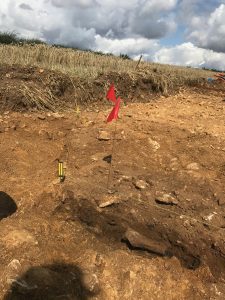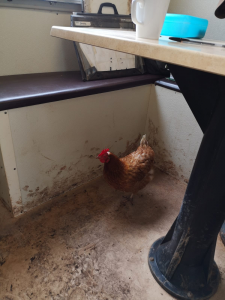New recruit is a feather in our cap
- 1st April 2020
We’re proud to welcome our newest team member – a highly specialised archaeologist helping us meet the challenges of both the current climate and a particular site.
Signs of an Iron Age settlement have recently been found during an excavation on the edge of Worcestershire. Alongside a boundary ditch was a large cluster of storage pits and several corn driers. As you can see below, it’s not always easy to differentiate between corn driers and stoney ground. What we needed was someone who could pick out the grain from the chaff…


The solution lay in the next field: hens. Not only are chickens experts at finding corn, they are (most importantly, given the current climate) immune to human strains of flu. It also pays to ask, as upon enquiring with the neighbouring farm it turned out that both the farmer and several of his feathery inhabitants share a passion for learning about the past.
With strict adherence to safety measures, supervisors were quickly able to procure the necessary Personal Protective Equipment and induct our first grain specialist.
Meet Henrietta. She proved incredibly friendly, popular and accurate – by the end of her first day she had assisted in locating and excavating three storage pits and two corn driers, saving hours of work.

Special care was taken to minimise risks and ensure Henrietta’s needs were met. Finds specialists can rest assured that no artefacts were swallowed, as the team found she was easily satisfied with water and a little corn. Grumblings did emerge though when Henrietta declined to join the tea rota and her preference between custard creams and bourbon biscuits is yet to be confirmed. Nevertheless, she egg-shelled at the tasks she was assigned and has undoubtedly boosted staff morale.
In light of recent developments, Worcestershire Archaeology are looking to train up a whole team of feathered archaeologists and considering expanding the programme to other virus immune staff. Recommendations gratefully received.
Thank you all for your responses and interest.
Sadly, though …you guessed it …Henrietta did not work well with our moles (trained in excavating stakeholes and postholes) and there was some foul play, so she has been let go.
It was a clucky break that we managed to get her in the first place – we shelled out enough.
We thank her for the way she egg-spertly handled her duties – she wasn’t winging it and she showed quite some hendurance – and though talk is cheap, we believe this is the first in a cereal of us being couped up safely while egg-sploring an egg-scape plan.
Have loved and shared your report of yesterday’s date.
….especially with w young archaeologist friends and our chicken-keeping vicar:-)